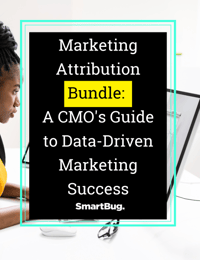
The Enterprise Attribution Problem: What’s Working, What’s Not, and What to Do About It
August 6, 2025
By Tracey Bauer
At its core, attribution isn’t a reporting problem—it’s a RevOps problem. Luckily, there’s a solution. And when done right, attribution acts as a powerful lever not only for reporting but also for decision-making across the enterprise.
In this episode of SmartBug On Tap, Senior Director of Channel Sales Casey Peddicord hosts SmartBug Senior Director of Account Strategy Sandy Moore as they dive deep into the complexities of attribution in enterprise marketing. They explore why attribution is so challenging at scale, how to build actionable models and avoid common pitfalls, and the evolving role of AI and data privacy in shaping attribution strategies.
Table of Contents
- Why Attribution Is So Challenging For Enterprise Organizations
- What Effective Attribution Models Look Like
- Common Pitfalls of Dashboards and Tools
- Simplifying Your Attribution Setup
- Tailoring Attribution Reporting For Executives vs. Teams
- Data Privacy Trends and the Role of AI
- Parting Advice: What to Start (and Stop) Doing
- Final Thoughts: Brand Impact and Measurement Challenges
Why Attribution Is So Challenging For Enterprise Organizations
Casey kicks off the episode by asking Sandy to pinpoint the primary reasons that attribution reporting is so troublesome for enterprise-level organizations. Sandy cites three primary challenges:
- Siloed data: Multiple tools, diverse tech stacks, and the sheer volume of employees tend to complicate decision-making.
- Lengthy customer journeys: Enterprise companies often sell a variety of products and services, prolonging the sales cycle.
- Numerous decision makers: Large enterprises involve a lot of decision makers, making it difficult to assign the right credit to the right source.
Red Flag: When Attribution Isn’t Working
So, how do you know when your attribution model just isn’t cutting it? Sandy offers some insight:
“If your revenue is not going up and you can't figure out why, that's the biggest red flag, because it means that you're not able to attribute what's working and what isn't. It means that the data is not driving the action, or worse, it could even be telling conflicting stories, so you're not even understanding what's happening. And maybe that means you've outgrown your current model … Let's say you have all this traffic coming to your website or you're creating all of this lead generation, but your revenue is not going up. Something is broken.”
What Effective Attribution Models Look Like
What about attribution approaches or models that are proven to work in a large, multi-touch, multi-team environment? Although she stresses that there’s no one-size-fits-all approach, Sandy recommends implementing hybrid attribution models. She suggests trying a U-shape model, or a multi-touch model that attributes 40 percent credit to the first touch, another 40 percent to the last touch, and then 20 percent for everything in between.
A “touch” or “touchpoint” refers to ways in which the prospect is interacting with the company before a deal is closed. Sandy’s advice is to layer your attribution models with custom lead scoring insights to help analyze what’s performing best and when. This makes it easier to look at different touchpoints and their complexity across channels. It provides a clearer picture and enables you to interpret all that data, versus if you give all that attribution to the first touch or the last touch. It’s simply not that linear in an enterprise setting.
Common Pitfalls of Dashboards and Tools
Casey mentions that HubSpot makes it easy to switch between various attribution models for different campaigns, but admits he’s partial to the platform’s “flashy” dashboards. He then asks Sandy what pitfalls to avoid when working within these reporting dashboards.
“If you don’t understand where [report data is] coming from … if you can't explain how those numbers are calculated, you’re going to be confused. Then all that great reporting doesn’t make sense … [and] you can’t work backwards to figure out what parts of the puzzle aren’t making sense because you don’t understand the formula for that calculation.”
Simplifying Your Attribution Setup
Because there are numerous touchpoints in the customer journey, enterprise companies tend to overcomplicate attribution. To avoid this, Sandy says, you must be very clear on your goals (bonus points for SMART goals). What are you looking to achieve? From there, you can start doing what Sandy refers to as the “backwards math”—the calculations that tell you how much revenue you have to have, how many deals you have to close, the average rate for closing a deal, and so on.
Sandy recommends utilizing existing data sources to identify opportunities for conversions. Then, “pick a simple model that outlines how you can attribute each of these marketing activities to line up with those goals.”
Tailoring Attribution Reporting For Executives vs. Teams
Executive-level reporting is completely different from what operations teams or various department heads need. For example, C-suite leaders typically report overall company progress to a board of directors, whereas a sales manager is more focused on the performance of their team members. To accommodate this, Sandy suggests creating different reporting dashboards based on role segments or tiers, then customizing each dashboard based on the specific reporting needs of that stakeholder segment.
Data Privacy Trends and the Role of AI
Because proper data access is paramount in an enterprise organization, Casey shifts the conversation to data privacy and its potential impact on attribution reporting. The privacy of user information is of utmost concern, and companies should prioritize data security over visibility.
However, data tracking limits (e.g., limitations on third-party cookies and IP tracking) can also create blind spots in attribution reporting, making multi-touch tracking slightly less reliable. This is why Sandy emphasizes the importance of using contextual information to understand user intent.
From here, Casey segues into AI’s role in attribution, asking Sandy about its influence on the customer journey. She mentions the colossal shift from traditional search engine optimization (SEO) to answer engine optimization (AEO), referring to search engines’ prioritization of AI-generated responses to user queries as opposed to the classic search engine results page (SERP).
AI answers have risen to the top of SERPs at breakneck speed, transforming how users access information. How does this impact attribution reporting? Although the person performing the search may get a more comprehensive answer, it can make marketing attribution a bit mucky. We used to optimize for SEO. Now, SEO has taken on a new persona.
“Those answers that AI gives when doing a simple search can be really difficult to change, [because the AI forms its] opinion by collecting data across a whole bunch of different websites. So if [the answer] is talking really highly of your products and services, that’s golden. But if it’s not, now you have this uphill battle to overcome, and [now you need to] figure out which part of your marketing mix is attributing to that answer.”
She goes on to say that diligent research is paramount for marketers to better understand what will move AI-generated responses to product-related queries in a positive direction.
AI: Helpful or Hype?
Casey continues to run with the topic of AI. He asks Sandy, “Is it truly helpful for you right now? Or is it just hype?” She responds matter-of-factly, “It’s a little bit of both.” She elaborates by saying that AI is incredibly helpful for pattern recognition and data analysis, helping assess heaps of data in a short time. However, a lack of human touch can “obscure that logic,” and users may make the mistake of blindly trusting what the AI is telling them.
Although AI can be of great help for processing data, interpreting and validating data should still be left to people, making governance and human oversight essential.
Sandy explains: “AI is a machine. It is looking at all of the data points and it's coming up with a conclusion. But it doesn't take into account all of those gray areas that a human can contextually grasp and incorporate into that logic.”
Parting Advice: What to Start (and Stop) Doing
When it comes to attribution reporting, Casey and Sandy agree that HubSpot reports need to be “taken with a grain of salt.” In other words, having the data is great, but the way you interpret the data is most important.
Sandy elaborates, “There can be so many complex use cases for why a certain attribution worked at one given point, and it might not necessarily work again.” But once you have the reports, you can compare and contrast to figure out what the data is actually telling you in the context of your business.”
And what should marketers stop doing? Sandy gives it to us straight: “Stop obsessing over the perfect attribution report or model. It doesn't exist, because there is no perfect linear report out there.” Basically, keep diving into your data, and the insights will come.
Final Thoughts: Brand Impact and Measurement Challenges
The focus of this episode is attribution reporting, so Casey and Sandy speak a lot about measuring marketing campaign results. But before they sign off, Sandy mentions that there’s always something to be said for brand recognition and brand awareness. As concepts, they’re not easy to track, but they are necessary for a holistic, layered approach to marketing and a key aspect of outreach.
Thanks for joining us for another episode of SmartBug On Tap. If you’re looking to fine-tune your attribution model or create more marketing impact, reach out to SmartBug for more information about our lifecycle solutions.

About the author
Tracey Bauer is a copywriter with 10+ years of experience and a background in content, advertising copywriting, and social media. She’s written for a wide range of industries, from technology to health to higher education, among others. A self-described generalist, Tracey has the skills to flex her voice and tone to the needs of any audience, and has been doing so for SmartBug since 2021. Read more articles by Tracey Bauer.









